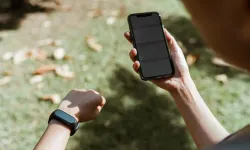(Press-News.org) PITTSBURGH (March 16, 2021) ... During the swarming of birds or fish, each entity coordinates its location relative to the others, so that the swarm moves as one larger, coherent unit. Fireflies on the other hand coordinate their temporal behavior: within a group, they eventually all flash on and off at the same time and thus act as synchronized oscillators.
Few entities, however, coordinate both their spatial movements and inherent time clocks; the limited examples are termed "swarmalators"1, which simultaneously swarm in space and oscillate in time. Japanese tree frogs are exemplar swarmalators: each frog changes both its location and rate of croaking relative to all the other frogs in a group.
Moreover, the frogs change shape when they croak: the air sac below their mouth inflates and deflates to make the sound. This coordinated behavior plays an important role during mating and hence, is vital to the frogs' survival. In the synthetic realm there are hardly any materials systems where individual units simultaneously synchronize their spatial assembly, temporal oscillations and morphological changes. Such highly self-organizing materials are important for creating self-propelled soft robots that come together and cooperatively alter their form to accomplish a regular, repeated function.
Chemical engineers at the University of Pittsburgh Swanson School of Engineering have now designed a system of self-oscillating flexible materials that display a distinctive mode of dynamic self-organization. In addition to exhibiting the swarmalator behavior, the component materials mutually adapt their overall shapes as they interact in a fluid-filled chamber. These systems can pave the way for fabricating collaborative, self-regulating soft robotic systems.
The group's research was published this week in the journal Proceedings of the National Academy of Sciences (DOI: 10.1073/pnas.2022987118). Principal investigator is Anna C. Balazs, Distinguished Professor of Chemical and Petroleum Engineering and the John A. Swanson Chair of Engineering. Lead author is Raj Kumar Manna and co-author is Oleg E. Shklyaev, both post-doctoral associates.
"Self-oscillating materials convert a non-periodic signal into the material's periodic motion," Balazs explained. "Using our computer models, we first designed micron and millimeter sized flexible sheets in solution that respond to a non-periodic input of chemical reactants by spontaneously undergoing oscillatory changes in location, motion and shape. For example, an initially flat, single sheet morphs into a three-dimensional shape resembling an undulating fish tail, which simultaneously oscillates back and forth across the microchamber."
The self-oscillations of the flexible sheets are powered by catalytic reactions in a fluidic chamber. The reactions on the surfaces of the sheet and chamber initiate a complex feedback loop: chemical energy from the reaction is converted into fluid flow, which transports and deforms the flexible sheets. The structurally evolving sheets in turn affect the motion of the fluid, which continues to deform the sheets.
"What is really intriguing is that when we introduce a second sheet, we uncover novel forms of self-organization between vibrating structures," Manna adds. In particular, the two sheets form coupled oscillators that communicate through the fluid to coordinate not only their location and temporal pulsations, but also synchronize their mutual shape changes. This behavior is analogous to that of the tree frog swarmalators that coordinate their relative spatial location, and time of croaking, which also involves a periodic change in the frog's shape (with an inflated or deflated throat).
"Complex dynamic behavior is a critical feature of biological systems," Shklyaev says. Stuff does not just come together and stop moving. Analogously, these sheets assemble in the proper time and space to form a larger, composite dynamic system. Moreover, this structure is self-regulating and can perform functions that a single sheet alone cannot carry out."
"For two or more sheets, the collective temporal oscillations and spatial behavior can be controlled by varying the size of the different sheets or the pattern of catalyst coating on the sheet," says Balazs. These variations permit control over the relative phase of the oscillations, e.g., the oscillators can move in-phase or anti-phase.
"These are very exciting results because the 2D sheets self-morph into 3D objects, which spontaneously translate a non-oscillating signal into "instructions" for forming a larger aggregate whose shape and periodic motion is regulated by each of its moving parts," she notes. "Our research could eventually lead to forms of bio-inspired computation - just as coupled oscillators are used to transmit information in electronics - but with self-sustained, self-regulating behavior."
INFORMATION:
How much do people have to pay for a travel permit to another country? A research team from Göttingen, Paris, Pisa and Florence has investigated the costs around the world. What they found revealed a picture of great inequality. People from poorer countries often pay many times what Europeans would pay. The results have been published in the journal Political Geography.
Dr Emanuel Deutschmann from the Institute of Sociology at the University of Göttingen, together with Professor Ettore Recchi, Dr Lorenzo Gabrielli and Nodira Kholmatova (from Sciences Po Paris, CNR-ISTI Pisa and EUI Florence respectively) compiled a new dataset on visa costs for travel between countries worldwide. The analysis shows that on average people ...
COLUMBUS, Ohio - The link between psychological stress and physical health problems generally relates to a stress-induced immune response gone wild, with inflammation then causing damage to other systems in the body. It's a predictable cascade - except in pregnancy, research suggests.
Scientists exploring the negative effects of prenatal stress on offspring mental health set out to find the immune cells and microbes in stressed pregnant mice most likely to trigger inflammation in the fetal brain - the source for anxiety and other psychological problems identified in previous research.
Instead, the researchers found two simultaneous conditions ...
Wearable electronic devices like fitness trackers and biosensors, are very promising for healthcare applications and research. They can be used to measure relevant biosignals in real-time and send gathered data wirelessly, opening up new ways to study how our bodies react to different types of activities and exercise. However, most body-worn devices face a common enemy: heat.
Heat can accumulate in wearable devices owing to various reasons. Operation in close contact with the user's skin is one of them; this heat is said to come from internal sources. Conversely, when a device is worn outdoors, sunlight acts as a massive external source of heat. These sources combined can easily raise the temperature ...
The vast majority of people infected with SARS-CoV-2 clear the virus, but those with compromised immunity--such as individuals receiving immune-suppressive drugs for autoimmune diseases--can become chronically infected. As a result, their weakened immune defenses continue to attack the virus without being able to eradicate it fully.
This physiological tug-of-war between human host and pathogen offers a valuable opportunity to understand how SARS-CoV-2 can survive under immune pressure and adapt to it.
Now, a new study led by Harvard Medical School scientists offers a look into this interplay, shedding light on the ways in which ...
A Florida State University professor's research could help quantum computing fulfill its promise as a powerful computational tool.
William Oates, the Cummins Inc. Professor in Mechanical Engineering and chair of the Department of Mechanical Engineering at the FAMU-FSU College of Engineering, and postdoctoral researcher Guanglei Xu found a way to automatically infer parameters used in an important quantum Boltzmann machine algorithm for machine learning applications.
Their findings were published in Scientific Reports.
The work could help build artificial neural networks ...
Prof. HUANG Weixin and ZHANG Qun from University of Science and Technology of China (USTC) of the Chinese Academy of Sciences (CAS), together with domestic collaborators, probed into the photocatalytic oxidation of methanol on various anatase TiO2 nanocrystals. The results were published on Angewandte Chemie International Edition.
Semiconductor-based photocatalysis has attracted extensive attention since its discovery, owing to its environmentally friendly production of chemical fuel utilizing solar energy.
A photocatalytic reaction consists of light absorption and charge generation within photocatalysts, ...
Nanozymes, a group of inorganic catalysis-efficient particles, have been proposed as promising antimicrobials against bacteria. They are efficient in killing bacteria, thanks to their production of reactive oxygen species (ROS).
Despite this advantage, nanozymes are generally toxic to both bacteria and mammalian cells, that is, they are also toxic to our own cells. This is mainly because of the intrinsic inability of ROS to distinguish bacteria from mammalian cells.
In a study published in Nature Communications, the research team led by XIONG Yujie and YANG Lihua from University of Science and Technology (USTC) of the Chinese Academy of Sciences (CAS) proposed a novel method to construct efficient-while-little-toxic nanozymes.
The researchers showed that nanozymes ...
Females who are fit and healthy tend to burn more fat when they exercise than men, according to new research from a team of sports nutritionists.
The research, comprising two new studies from academics led by the University of Bath's Centre for Nutrition, Exercise & Metabolism, analysed the factors that most influenced individuals' capacity to burn body fat when undertaking endurance sports.
How the body burns fat is important to all of us for good metabolic health, insulin sensitivity and in reducing the risk of developing Type II diabetes. But, for endurance sport ...
Research led by the Cavendish Laboratory at the University of Cambridge has identified a material that could help tackle speed and energy, the two biggest challenges for computers of the future.
Research in the field of light-based computing - using light instead of electricity for computation to go beyond the limits of today's computers - is moving fast, but barriers remain in developing optical switching, the process by which light would be easily turned 'on' and 'off', reflecting or transmitting light on-demand.
The study, published in Nature Communications, shows that a material known as Ta2NiSe5 could switch between a window and a mirror in a quadrillionth of a second when struck by a short laser pulse, paving the way for the development ...
The bacterial equivalent of a traffic jam causes multilayered biofilms to form in the presence of antibiotics, shows a study published today in eLife.
The study reveals how the collective behaviour of bacterial colonies may contribute to the emergence of antibiotic resistance. These insights could pave the way to new approaches for treating bacterial infections that help thwart the emergence of resistance.
Bacteria can acquire resistance to antibiotics through genetic mutations. But they can also defend themselves via collective behaviours such as joining together ...



